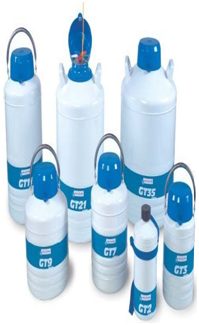Energy Calculation for Nitrogen (State Change)

contain_pic
To make liquid nitrogen there are many filtering processes that nitrogen gas is put through. Each of these processes require energy to be transferred from the nitrogen in the air to a surrounding environment. In order to produce liquid nitrogen, energy must be lost from the individual nitrogen molecules to the coolant being used in the refrigeration cycle. The temperature of the nitrogen must be brought down from that of the outside environment to a temperature either at or lower than the boiling point of nitrogen which is -195.8oC . Below is a simple calculation of how much energy must be taken out of a container with 10 kg of nitrogen gas already at -190oC and is brought to a typical storage temperature of about -197oC for liquid nitrogen. This is to show the amount of energy required to be removed from the nitrogen molecules after has gone through the Cryogenic Air Separation Steps that are provided on the "Process for Making Liquid Nitrogen" portion of this site.
- Introducing the Equation
Qhot = Qgas + Qvaporization + Qliquid
Variable Declarations
Qhot = is the total energy loss required of the designated amount of nitrogen in order to convert it all to a liquid form and to its preferred storage temperature
Qgas – is the energy required to take a specified amount of gaseous nitrogen and lower its temperature to that of nitrogen’s boiling point (point of vaporization).
Qvaporization – is the energy required to change a specified amount of gaseous nitrogen to a liquid form.
Qliquid – is the additional energy required to reduce the temperature of the liquefied nitrogen to a designated temperature.
Mnitrogen – is the amount of nitrogen being either cooled or changing state.
Cnitrogen – is the specific heat of nitrogen as a gas
CL-nitrogen – is the specific heat of nitrogen as a liquid
Lnitrogen – is the latent heat of nitrogen
detaT – is the change in temperature
Ti – is the initial temperature
Tf – is the final temperature
T0 – is the specific temperature of (0oC)
Variable and Equation Expansion
-- Qgas = Mnitrogen X Cnitrogen X deltaT -- Qvaporization = -Lnitrogen X Mnitrogen
-- Qliquid = Mnitrogen X CL-nitrogen X deltaT
Working Equation:
Qhot = Mnitrogen X Cnitrogen X deltaT - Lnitrogen X Mnitrogen + Mnitrogen X CL-nitrogen X deltaT
- Plugging in Values and Calculation
Qhot = (10kg)(1.04 kJ/kgK)(-195.8oC+190oC) - (200 kJ/kg)(10kg) + (10kg)(2.04 kJ/kgK)(-197+195.8) = - 2.08 MJ
